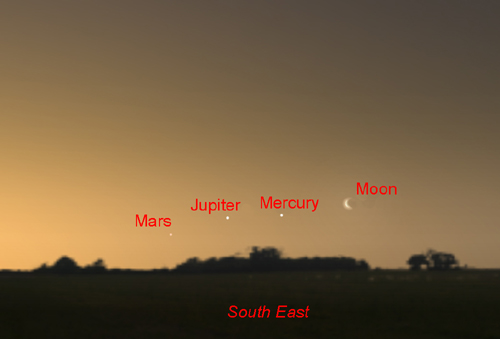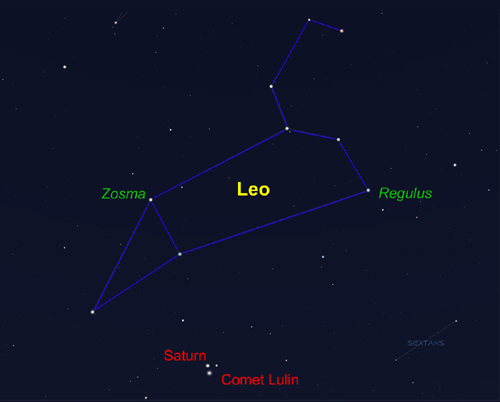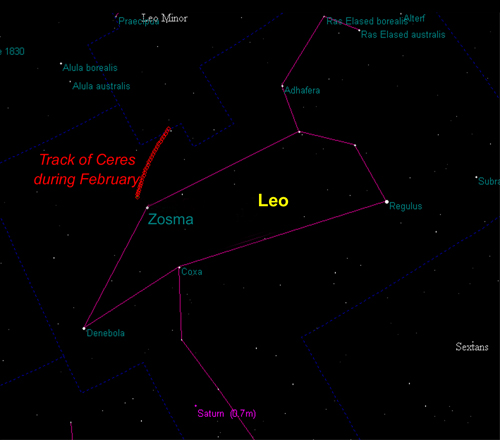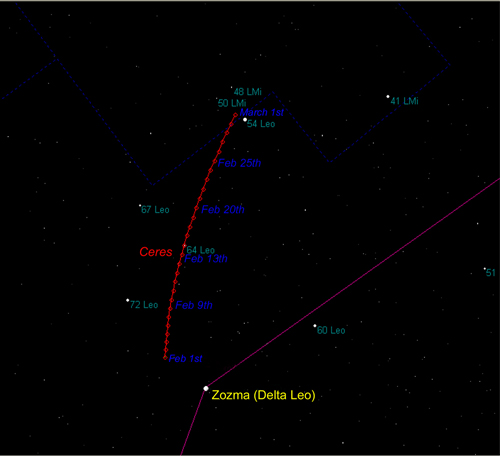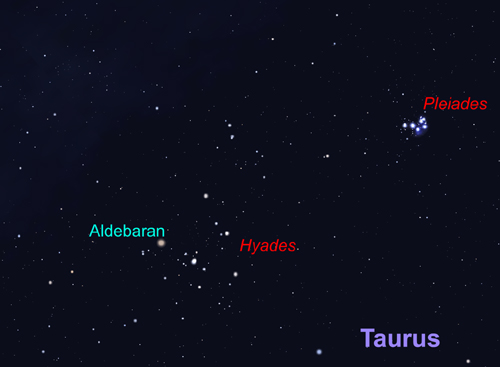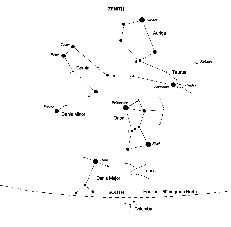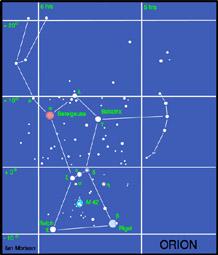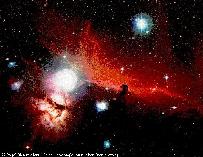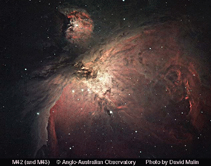The Night Sky February 2009
Compiled by Ian Morison
This page, updated monthly, will let you know some of the things that you can look out for in the night sky. It lists the phases of the Moon, where you will see the naked-eye planets and describes some of the prominent constellations in the night sky during the month.
Image of the Month
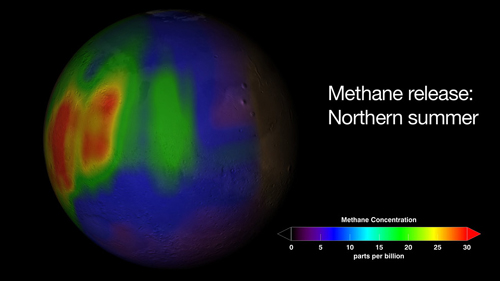
Methane in the Martian Atmosphere
Image: NASA
Claims that the Martian atmosphere contains methane that have existed since 2003 were confirmed by NASA from ground based spectroscopic measurements - adsorption bands in the spectra matching those of methane gas. This is very interesting because methane will be destroyed in the Martian atmosphere within a few years and the observations thus imply that methane must be being release into the atmosphere at the present time. There are two possible sources of methane. The first, and most exciting, is that it has a biological origin and that microbes beneath the surface are currently producing it or have done so in the past and the gas is now being releasd. If this is true, it opens up the possibility that life might still be present on Mars today! However, the methane could be the result of purely geological processes involving volcanism. There is no obvious volcanic activity today, but it could be that ancient methane trapped in ice cages called claththrates might now be being released.
Highlights of the Month
February 22nd: Mars, Jupiter, Mercury and a thin crescent moon
This is a tough one! As mentioned below, in the morning the ecliptic is at a very shallow angle to the south-eastern horizon at this time of year so, althought the planets are at reasonable angles from the Sun, they are very low above the horizon and easily lost in the Sun's glare. To observe this nice grouping you will need a very low eastern horizon and a pair of binocululars will help. The Moon will be pretty obvious but the planets less so. Do not continue looking for them after the Sun has risen for fear of damaging your eyes.
February 22nd to 24th: Observe Comet Lulin just below Saturn in the late evening.
Comet Lulin is approaching the Earth and by the end of the month may well reach magnitude 5 - so just visible to the unaided eye. Perhaps the easiest time to look for it with binoculars is around February 23th when its path passes just below the planet Saturn making it very easy to find. It is moving up to the right, so to the lower left of Saturn on the 22nd, below on the 23rd and to the lower right on the 24th. The fourth magnitude star Sigma Leoinis is to the right of Saturn: the comet will lie below the pair and should appear "fuzzy". On the night of the 23rd February, it is closest to the Earth (60 million km) and will lie just 2 degrees below Saturn.
February: Use Binoculars to spot a Dwarf Planet!
Ceres, the largest of the minor planets or asteroids in the main asteroid belt between Mars and Jupiter has now been accorded the status of a dwarf planet as its size and mass is sufficient to make it spherical in shape. The plot on the left shows that, in February, it will lie just above the star Zosma which forms the hindquarters of Leo, whilst that on the right shows more accuratly where it will lie throughout the month of February. It will be around magnitude 7 (varying from 6.9 to 7.2) and will be easy to spot in binoculars from a reasonably dark site. Try to spot its motion over a few nights!
February: A great time to observe the Hyades and Pleiades Clusters.
This is great month to observe the two nearest open clusters to us - the Hyades and Pleiades Clusters. The Pleiades Cluster is one of the youngest open clusters and is dominated by blue stars that have been formed within the last 100 million years. None have yet evolved into red giant stars - so helping to define its age. It appears to be passing through a cloud of dust which is scattering the blue light form the stars forming so called "reflection nebulae" around the brighter stars of the cluster. The Pleiades are a lovely sight in high power binoculars or a short focal length telescope. The closer Hyades Cluster is older and does contain some evolved stars. The stars Aldebaran, the eye of the Bull, lies about halfway between the Hyades Cluster and the Earth so is not part of it.
Observe the International Space Station

The International Space Station and Jules Verne passing behind the Lovell Telescope on April 1st 2008.
Image by Andrew Greenwood
Use the link below to find when the space station will be visible in the next few days. In general, the space station can be seen either in the hour or so before dawn or the hour or so after sunset - this is because it is dark and yet the Sun is not too far below the horizon so that it can light up the space station. As the orbit only just gets up the the latitude of the UK it will usually be seen to the south, and is only visible for a minute or so at each sighting. Note that as it is in low-earth orbit the sighting details vary quite considerably across the UK. The NASA website linked to below gives details for several cities in the UK. (Across the world too for foreign visitors to this web page.)
Note: I observed the ISS three times in the last week or so of July and was amazed as to how bright it has become.
Find details of sighting possibilities from your location from: Location Index
See where the space station is now: Current Position
The Moon

The Moon at 3rd Quarter. Image, by Ian Morison, taken with a 150mm Maksutov-Newtonian and Canon G7.
Just below the crator Plato seen near the top of the image is the mountain "Mons Piton". It casts a long shadow across the maria from which one can calculate its height - about 6800ft or 2250m.
| new | first quarter | full moon | last quarter |
|---|---|---|---|
| February 24th | February 2nd | February 9th | February 16th |
Some Lunar Images by Ian Morison, Jodrell Bank Observatory: Lunar Images
The Planets
Jupiter
Jupiter is not easily visible this month having passed behind the Sun on January 24th. By the very end of February it will be 28 degrees from the Sun, and at magnitude -2 might just be glimpsed very low south-east just before dawn. It will only be ~7 degrees above the horizon so binoculars may well be needed. See highlight above. Better wait a month or so!Saturn
Saturn is now the best placed planet in the sky - and you no longer need to wait up too late at night to observe it! It rises in the east at around 09:30pm at the beginning of the month and at ~ 7:30pm at month's end.. It can be seen high in the southern sky in the hours before dawn. Lying below the outline of Leo, it has a magnitude of ~0.7 throughout the month. This is significantly less than it often appears as the rings are now, with a tilt of about 1 degree, almost edge on! In September this year they will become edge on to us and become invisible! See highlight above as Comet Lulin passes just 2 degrees below Saturn on the 23rd February.
Mercury
Mercury: passed in front of the Sun on the 20th January and so, in February, will be rising before the Sun. I lies furthest in angle from the Sun around the 16th February but, sadly, will only be ~7 degrees above the horizon before the Sun rises so making it very difficult to spot. This is because at this time of the year the ecliptic (where the Sun and planets are found) lies at a very shallow angle to the horizon. However, around the 16th, the use of binoculars and a very low eastern horizon might enable you to spot it shining at magnitude 0.0. It will form a difficult to observe grouping with Mars and Jupiter on the 22nd. See highlight above.
Mars
Mars is still very close in angle to the Sun (just 15 degrees as Feburary begins) so will be very hard to spot in the predawn sky having a magnitude of 1.3. By the end of the month the angular sepeartion has increased to 21 degrees which helps, but as mentioned in relation to Mercury, the ecliptic makes sush a small angle to the horizon that Mars will be just 4 degrees above the horizon as the Sun rises. We will have to wait a month or so until it will be seen easily in the pre-dawn sky, but see the highlight above for a possible chance on Feb 22nd.
Venus
Venus can now be seen high in the west after sunset shining at magnitude -4.5 so can hardly be missed! It sets at about 9:15 at the beginning of February and this stays pretty constant during the month as Venus gradually gets closer in angle to the Sun. As the month progresses its brightness increases fractionally to a magnitude of -4.5. As the month progresses, the angular size increases, but the percentage that is illuminated will drop. These two effects tend to cancel out in the way they affect its apparent brightness which is why the brightness remains almost constant for several months. Venus is moving to a higher declination in the sky now, which is why it is far more prominent than it has appeared for some time.
Find more planetary images and details about the Solar System: The Solar System
The Stars
The Mid Evening February Sky
This map shows the constellations seen in the south during the evening. The brilliant constellation of Orion is seen in the south. Moving up and to the right - following the line of the three stars of Orion's belt - brings one to Taurus; the head of the bull being outlined by the V-shaped cluster called the Hyades with its eye delineated by the orange red star Aldebaran. Further up to the right lies the Pleaides Cluster. Towards the zenith from Taurus lies the constellation Auriga, whose brightest star Capella will be nearly overhead. To the upper left of Orion lie the heavenly twins, or Gemini, their heads indicated by the two bright stars Castor and Pollux. Down to the lower left of Orion lies the brightest star in the northern sky, Sirius, in the consteallation Canis Major. Up and to the left of Sirius is Procyon in Canis Minor. Rising in the East is the constellation of Leo, the Lion, with the planet Saturn up and to the right of Regulus its brightest star. Continuing in this direction towards Gemini is the faint constellation of Cancer with its open cluster Praesepe (also called the Beehive Cluster),the 44th object in Messier's catalogue. On a dark night it is a nice object to observe with binoculars. There is also information about the constellation Ursa Major,seen in the north, in the constellation details below.
The constellation Taurus
Taurus is one of the most beautiful constellations and you can almost imagine the Bull charging down to the left towards Orion. His face is delineated by the "V" shaped cluster of stars called the Hyades, his eye is the red giant star Aldebaran and the tips of his horns are shown by the stars beta and zeta Tauri. Although alpha Tauri, Aldebaran, appears to lie amongst the stars of the Hyades cluster it is, in fact, less than half their distance lying 68 light years away from us. It is around 40 times the diameter of our Sun and 100 times as bright.
To the upper right of Taurus lies the open cluster, M45, the Pleiades. Often called the Seven Sisters, it is one of the brightest and closest open clusters. The Pleiades cluster lies at a distance of 400 light years and contains over 3000 stars. The cluster, which is about 13 light years across, is moving towards the star Betelgeuse in Orion. Surrounding the brightest stars are seen blue reflection nebulae caused by reflected light from many small carbon grains. These relfection nebulae look blue as the dust grains scatter blue light more efficiently than red. The grains form part of a molecular cloud through which the cluster is currently passing. (Or, to be more precise, did 400 years ago!)
Close to the tip of the left hand horn lies the Crab Nebula, also called M1 as it is the first entry of Charles Messier's catalogue of nebulous objects. Lying 6500 light years from the Sun, it is the remains of a giant star that was seen to explode as a supernova in the year 1056. It may just be glimpsed with binoculars on a very clear dark night and a telescope will show it as a misty blur of light.
Its name "The Crab Nebula" was given to it by the Third Earl of Rosse who observed it with the 72 inch reflector at Birr Castle in County Offaly in central Ireland. As shown in the drawing above, it appeared to him rather lile a spider crab. The 72 inch was the world's largest telelescope for many years. At the heart of the Crab Nebula is a neutron star, the result of the collapse of the original star's core. Although only around 20 km in diameter it weighs more than our Sun and is spinning 30 times a second. Its rotating magnetic field generate beams of light and radio waves which sweep across the sky. As a result, a radio telescope will pick up very regular pulses of radiation and the object is thus also known a Pulsar. Its pulses are monitored each day at Jodrell Bank with a 13m radio telescope.
The constellation Orion
Orion, perhaps the most beautiful of constellations, will be seen in the south at around 11 - 12 pm during January. Orion is the hunter holding up a club and shield against the charge of Taurus, the Bull up and to his right. Alpha Orionis, or Betelgeuse, is a read supergiant star varying in size between three and four hundred times that of our Sun. The result is that its brightness varies somewhat. Beta Orionis, or Rigel, is a blue supergiant which, at around 1000 light years distance is about twice as far away as Betelgeuse. It has a 7th magnitude companion. The three stars of Orion's belt lie at a distance of around 1500 light years. Just below the lower left hand star lies a strip of nebulosity against which can be seen a pillar of dust in the shape of the chess-board knight. It is thus called the Horsehead Nebula. It shows up very well photographically but is exceedingly difficult to see visually - even with relativly large telescope.
Beneath the central star of the belt lies Orion's sword containing one of the most beautiful sights in the heavens - The Orion Nebula. It is a region of star formation and the reddish colour seen in photographs comes from Hydrogen excited by ultraviolet emitted from the very hot young stars that make up the Trapesium which is at its heart. The nebula, cradling the trapesium stars, is a beautiful sight in binoculars or, better still, a telescope. To the eye it appears greenish, not red, as the eye is much more sensitive to the green light emitted by ionized oxygen than the reddish glow from the hydrogen atoms.
The constellation Ursa Major
The stars of the Plough, shown linked by the thicker lines in the chart above, form one of the most recognised star patterns in the sky. Also called the Big Dipper, after the soup ladles used by farmer's wives in America to serve soup to the farm workers at lunchtime, it forms part of the Great Bear constellation - not quite so easy to make out! The stars Merak and Dubhe form the pointers which will lead you to the Pole Star, and hence find North. The stars Alcor and Mizar form a naked eye double which repays observation in a small telescope as Mizar is then shown to be an easily resolved double star. A fainter reddish star forms a triangle with Alcor and Mizar.
Ursa Major contains many interesting "deep sky" objects. The brightest, listed in Messier's Catalogue, are shown on the chart, but there are many fainter galaxies in the region too. In the upper right of the constellation are a pair of interacting galaxies M81 and M82 shown in the image below. M82 is undergoing a major burst of star formation and hence called a "starburst galaxy". They can be seen together using a low power eyepiece on a small telescope.
Another, and very beautiful, galaxy is M101 which looks rather like a pinwheel firework, hence its other name the Pinwheel Galaxy. It was discovered in1781 and was a late entry to Messier's calalogue of nebulous objects. It is a type Sc spiral galaxy seen face on which is at a distance of about 24 million light years. Type Sc galaxies have a relativly small nucleus and open spiral arms. With an overall diameter of 170,000 light it is one of the largest spirals known (the Milky Way has a diameter of ~ 130,000 light years).
Though just outside the constellation boundary, M51 lies close to Alkaid, the leftmost star of the Plough. Also called the Whirlpool Galaxy it is being deformed by the passage of the smaller galaxy on the left. This is now gravitationally captured by M51 and the two will eventually merge. M51 lies at a distance of about 37 million light years and was the first galaxy in which spiral arms were seen. It was discovered by Charles Messier in 1773 and the spiral structure was observed by Lord Rosse in 1845 using the 72" reflector at Birr Castle in Ireland - for many years the largest telescope in the world.
Lying close to Merak is the planetary nebula M97 which is usually called the Owl Nebula due to its resemblance to an owl's face with two large eyes. It was first called this by Lord Rosse who drew it in 1848 - as shown in the image below right. Planetary nebulae ar the remnants of stars similar in size to our Sun. When all possible nuclear fusion processes are complete, the central core collpses down into a "white dwarf" star and the the outer parts of the star are blown off to form the surrounding nebula.


